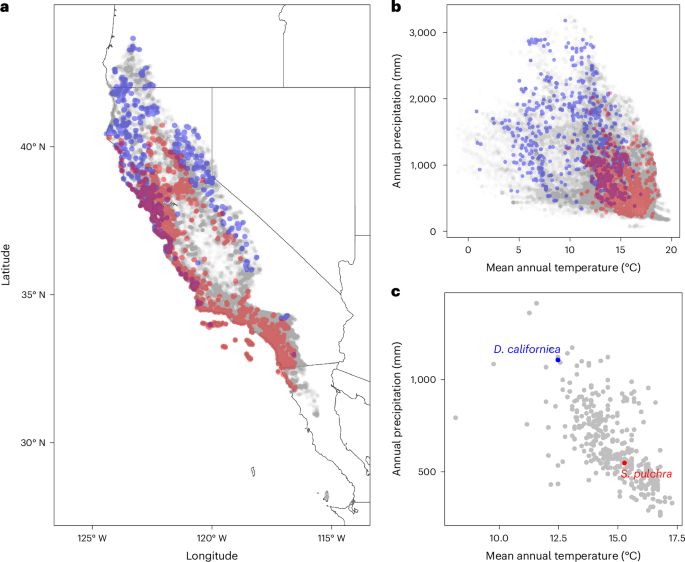气候变化导致草原群落迅速变化
IF 13.9
1区 生物学
Q1 ECOLOGY
引用次数: 0
摘要
许多陆地植物群落,特别是森林,对快速气候变化的反应滞后。草地群落对新气候的反应可能更快,因为它们主要由寿命较短的物种组成,直接暴露于宏观气候变化中。在此,我们报告了加利福尼亚花卉省草原群落对气候变化的快速反应。我们从 829,337 条出现记录中估算了 349 种维管植物的气候生态位,汇编了来自 12 项观测研究和 3 项全球变化实验的 15 个长期群落组成数据集,并分析了气候生态位空间中的群落组成变化。我们的研究表明,群落经历了向与温暖和干旱地区相关的物种的显著迁移,迁移率分别为 0.0216 ± 0.00592 °C yr-1(平均值 ± s.e.)和 -3.04 ± 0.742 mm yr-1,这些变化发生的速度与气候变暖和干燥的速度相似。这些方向性变化在观测和实验中都是一致的。我们的研究结果与在以长寿植物为主的群落中观察到的滞后反应形成鲜明对比,表明在不久的将来,生物多样性的变化会比预期的更大。本文章由计算机程序翻译,如有差异,请以英文原文为准。


Rapid shifts in grassland communities driven by climate change
Many terrestrial plant communities, especially forests, have been shown to lag in response to rapid climate change. Grassland communities may respond more quickly to novel climates, as they consist mostly of short-lived species, which are directly exposed to macroclimate change. Here we report the rapid response of grassland communities to climate change in the California Floristic Province. We estimated 349 vascular plant species’ climatic niches from 829,337 occurrence records, compiled 15 long-term community composition datasets from 12 observational studies and 3 global change experiments, and analysed community compositional shifts in the climate niche space. We show that communities experienced significant shifts towards species associated with warmer and drier locations at rates of 0.0216 ± 0.00592 °C yr−1 (mean ± s.e.) and −3.04 ± 0.742 mm yr−1, and these changes occurred at a pace similar to that of climate warming and drying. These directional shifts were consistent across observations and experiments. Our findings contrast with the lagged responses observed in communities dominated by long-lived plants and suggest greater biodiversity changes than expected in the near future. Plant community responses to climate change tend to be lagged in forests, but could be faster in grasslands. Here, the authors integrate long-term experimental data with >1 million occurrence records for >300 species, finding grassland community shifts towards species associated with warmer and drier conditions at a pace that aligns with that of climate change.
求助全文
通过发布文献求助,成功后即可免费获取论文全文。
去求助
来源期刊

Nature ecology & evolution
Agricultural and Biological Sciences-Ecology, Evolution, Behavior and Systematics
CiteScore
22.20
自引率
2.40%
发文量
282
期刊介绍:
Nature Ecology & Evolution is interested in the full spectrum of ecological and evolutionary biology, encompassing approaches at the molecular, organismal, population, community and ecosystem levels, as well as relevant parts of the social sciences. Nature Ecology & Evolution provides a place where all researchers and policymakers interested in all aspects of life's diversity can come together to learn about the most accomplished and significant advances in the field and to discuss topical issues. An online-only monthly journal, our broad scope ensures that the research published reaches the widest possible audience of scientists.
 求助内容:
求助内容: 应助结果提醒方式:
应助结果提醒方式:


